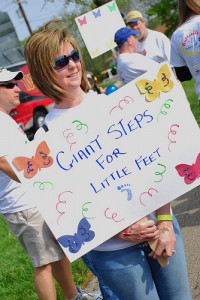Lisa Desatnik
Her Passion For Dogs Has Rescued Nearly 12,000 Animals
I love hearing about how people with a passion are making a real difference. When I was at the SPCA Fur Ball, I learned of one woman…Christina Hamberg.
Each year the SPCA Cincinnati presents its P.B. Johnston Humane Care Award to an outstanding member of the  community for his or her dedication to animal welfare. Christina was that member this year.
community for his or her dedication to animal welfare. Christina was that member this year.
Her first contact with the SPCA was in the 1990s when she volunteered to walk dogs. But she didn’t just walk any dog, Christina sought out those who had been at the shelter the longest. And, when she was there, she took note of the litters of puppies in need of love and began outreach to find foster homes.
Sheltered Paws Dog Rescue
Christina’s passion led to starting a non-profit of her own, Sheltered Paws Dog Rescue, to save shelter dogs requiring temporary foster home and then place those dogs in permanent homes; and to partner with the SPCA Cincinnati to promote the place of their dogs with disabilities. Over the last 15 years, her rescue has fostered and helped nearly 12,000 animals.
Sheltered Paws Mission: To develop trust and love with a dog that needs to be reminded that many humans can and will take good, loving care of it for the rest of its lives. To then find loving homes for these previously abused, abandoned, sick, neglected and confused dogs. To give the dog a solid re-start with behavior, health, and trust. To spay/neuter our rescued dogs of age to stop the cycle of unwanted litters.
Northern Kentucky Anti-Bullying Campaign Needs Your Help
A few weeks ago I introduced you to Ryan Courtade, founder of a non-profit, all-volunteer organization called Northern Kentucky Youth Foundation. It is a resource and partner for educators and organizations committed to the success of young people; and the Foundation is a strong advocate for youth in Boone, Kenton and Campbell counties with programs that now include bullying prevention.
And Ryan needs your help. He is in the process of developing an anti-bullying campaign to launch in the fall with a focus on empowering the bystanders. It will use various media to relay information including a video, printed materials and  the internet. Ryan wants to engage youth rather than using only school-wide assemblies and other traditional methods.
the internet. Ryan wants to engage youth rather than using only school-wide assemblies and other traditional methods.
Do you have some time and resources to give to help? Any businesses, agencies or community members interested in assisting with the anti-bullying efforts should call him at 859-795-1506 or visit www.nkyyouth.org for more information.
In Hanna’s Memory, The Butterfly Walk Is Fighting Cancer In Kids
I can’t think of anything more tragic for parents than losing their beautiful, precious child far too soon to the senseless and vicious enemy known as cancer.
 Hanna was a happy, healthy 2 ½ year old girl who loved to smile and laugh and spread sunshine where ever she went. It was just two days after she told her mom and dad her back hurt, that she was diagnosed with Neuroblastoma, a cancer that develops in the nervous system in embryo. Suddenly a family who was counting their blessings was entrenched in a war against an enemy that had no sympathy.
Hanna was a happy, healthy 2 ½ year old girl who loved to smile and laugh and spread sunshine where ever she went. It was just two days after she told her mom and dad her back hurt, that she was diagnosed with Neuroblastoma, a cancer that develops in the nervous system in embryo. Suddenly a family who was counting their blessings was entrenched in a war against an enemy that had no sympathy.
After only seven short months, many surgeries, and 6 rounds of chemotherapy, Hanna lost her battle with this disease on Father’s Day 2006.
Her gift to this world continues.
But while the little girl with a smile that spread as quickly as her disease was no longer on this earth, cancer could not remove her spirit. What a true sense of bravery and love her parents have shown in allowing their daughter’s gift to touch so many other families and children.
In Hanna’s memory, Amy and Mike Paribello began the Butterfly Walk to benefit CancerFree Kids. “We can only hope that with further research funding, children like Hanna will have a better chance for a cure in the future. Hanna showed us all how to fight a battle, how to be courageous, and how to dream,” Amy said.
The Butterfly Walk is May 12.
The Butterfly Walk and Fun Festival brings together people and businesses who share in the celebration of love and support for children. The name was inspired by the magical metamorphosis of a caterpillar into an enchanting symbol of peace and harmony. That transformation into maturity is something not all children with cancer have an  opportunity to experience.
opportunity to experience.
“But,” said Amy, “together we can make a difference and help further the research towards treating and curing this disease, forever.”
If you visit the Butterfly Walk website you will read the stories of so many other children who are the reason the Paribello’s and all of the other volunteers work so hard.
I asked Amy how it feels to know they are making such an impact. “I am fueled by the constant need to continue our fight. Over the past 6 years, we have lost 3 of our “heros”, who have lost their battle with cancer. It is heartbreaking to know that one year they are up on stage receiving a medal for their courage, and then the next year they are an angel in heaven. We are truly committed to giving these children a voice, and fighting for their survival by advancing the progress of pediatric cancer research. Our mission is for one day for all kids to be CancerFree.”
Butterfly Walk & 5K
Registration will begin at 8 a.m.
Cottell Park in Deerfield Township
Cincinnati nonprofit CancerFree Kids was founded by Ellen and Sam Flannery after their baby daughter was diagnosed with cancer at 5 months of age. Today, due to advances in cancer research and the grace of God, that baby is a healthy 8th grader. But there is much work to do. The organization raises funds to support research in pediatric cancer.
A Logical Explanation For Why Your Dog Doesn’t Come
So often dog owners want to know why they can’t get their dog to come every time he is called no matter what he happens to be doing or where. “He can be stubborn.” “He has a mind of his own.” “His breed is like that.” These are all reasons I’ve heard people use.
The truth is if your dog is not behaving in a way you want him to behave, it is a clear indication that either he does not know what you want him to do (the criterion for reinforcement is unclear) and/or the reinforcer for the right behavior isn’t strong enough or delivered fast enough to compete with the reinforcers available for doing something other than coming to you. When given a choice, animals will generally choose the behavior that produces the most valued outcomes. For example, a dog may know a sit cue (he’s done it a million times in the past) but he may choose to ignore it sometimes because the outcome is of far less value to him than the competing reinforcers at those times.
Here are just some reasons why your dog may choose to do anything BUT come when called:
1)There is a weak history of reinforcement associated with you. Think about it. How totally awesome do you make the experience of being at your side? Does your dog see you as the giver of all good things?
2)There is a strong, established history with competing reinforcers from the environment, which are more valuable to the dog than what coming to you offers. It’s really tough to compete with the value of rabbit or squirrel. And if you call and call your dog in this situation, you will be further weakening the cue to come because a cue that doesn’t reliably predict reinforcement loses its value and thus its reliability to predict behavior. Very often the word ‘come’ takes on the meaning of ‘keep playing, go sniff the flowers, and only when there isn’t anything more reinforcing to do, then come to my side.’
3)If your dog doesn’t come to you reliably when called, why set both of you up for failure by calling him back to you at a time when you can predict he more than likely won’t come (like when he is in pursuit of a squirrel or playing in water).
Instead, let your dog play until he is good and tired and you can predict that the chances are high that he will come when called (and you can then have a party when he does choose to come to make that choice totally awesome). Of course the other suggestion is to work on teaching the ‘come’ cue reliably by starting in an environment without distractions and systematically building on the distractions.
4)Your dog can not reliably predict that every time he comes when called it will be worth his while. As an example, maybe you have a history of letting your dog outside just before you have to leave and call him inside to be locked up. Your recall cue may be associated with a loss – the loss of his freedom, the loss a toy, etc. Maybe you sometimes punish your dog when he comes back to you after taking chase. You may try to trick your dog into coming by luring him with a toy or something of value but after a couple of times, he has you figured out.
5)Not coming to you results in a bigger pay day. Maybe if he doesn’t come, it results in you chasing him – and what dog doesn’t like to be chased?
6)There is a strong dependency of confinement whether to a leash or to a space that teaches your dog he only needs to pay attention when under your tether. Think about the mischief children get into when their parents go out of town or when they go off to college. The solution is more work systematically generalizing the skills from one setting to another.
These are some of many reasons why your dog doesn’t come when called – and none of them have to do with being stubborn or headstrong. What they all have in common is the poor use of strategic strong, consistent reinforcement on your part to teach your dog that coming to you is absolutely the best choice for him.















